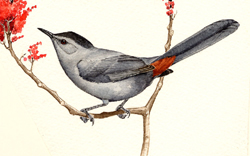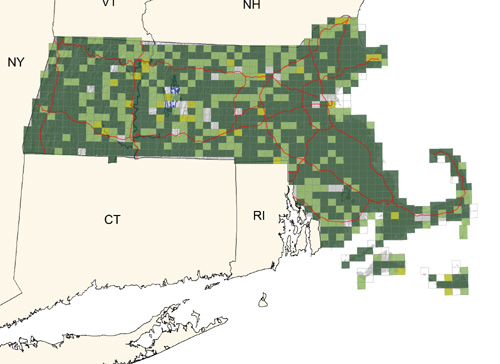Breeding Bird Atlases (BBA)
Find a Bird - BBA1
Breeding Bird Atlas 1 Species Accounts
Gray Catbird
Dumetella carolinensis
Egg Dates
May 3 to August 15
Number of Broods
one or two

The Gray Catbird is a common and well-known summer resident throughout the state—a reflection of the ubiquity of its preferred habitat of suburbs, overgrown fields, and woodland edges. It is especially abundant along the coastal plain, such as on Plum Island and Cape Cod, where the profusion of berry-producing shrubs provides both food and nesting cover.
The first migrants show up in early May, but the bulk of the residents do not arrive until mid- to late May. Adult male catbirds arrive first on their breeding ground and immediately begin to establish territories through vigorous singing from exposed perches. A catbird’s territory ranges from about one to three acres, and the bird usually concentrates its activities inside these boundaries. Disputes with neighboring catbirds over territorial boundaries are settled with loud song and chases.
The song of the catbird is given only by the male and consists of a long series of different phrases, some of which imitate the songs and calls of other birds. The best-known call of the Gray Catbird is the meow call, which is given by both sexes and sounds like a cat. It is most often given during aggressive encounters and in response to predators. Other calls include a grating kak-kak-kak and a soft chuck.
Females arrive on the breeding grounds one to two weeks after the males, and initial courtship consists of the male’s repeatedly chasing the female for short distances within the territory. During these chases, which may last up to one-half hour, both the male and female may do a display in which they fluff out all of their contour feathers so that they appear to be about the size of a softball.
Soon after the establishment of the pair bond, nest building begins. At first, both the male and female may carry twigs about, placing them in several trial locations. But, within a few days, the nest site is selected and nest building begins in earnest by the female. It takes 5 to 8 days to complete the nest. The nest is usually located in dense vegetation, 2 to 10 feet high, and is a bulky collection of twigs, grape or Red Cedar bark, and fern rootlets as lining. Locations for 39 state nests were as follows: shrubs and low vegetation (32 nests), conifer (4 nests), hedge (3 nests) (CNR). Heights of these nests ranged from 2 to 9 feet, with an average of 5.2 feet (CNR).
Egg laying begins as soon as the nest is completed. Three to four turquoise blue eggs is the usual clutch, and incubation begins with the laying of the last egg. The female does all of the incubation. When she is not at the nest, the male replaces her to protect the nest, but he does not incubate. This coordination of activities around the nest is accomplished with short, quiet fragments of song, a call that sounds like kwut, a wing-raised display, and the male presenting food to the female. Clutch sizes for 32 state nests were two eggs (2 nests), three eggs (11 nests), four eggs (18 nests), five eggs (1 nest) (CNR).
The young hatch in about 13 days. For the first few days, the female broods the nestlings and the male supplies her with food, which she in turn feeds to the young. In a few days, both sexes bring food to the nestlings. After about two weeks in the nest, the young birds fledge but are still fed by the parents for another two weeks. A second brood may occur, in which case the female builds a new nest in a different part of the territory. Brood sizes for 20 state nests were two young (5 nests), three young (8 nests), four young (7 nests) (CNR). Nestlings have been reported in Massachusetts from June 9 to August 13 and fledglings from June 19 to August 12 (CNR). Outcomes for 39 state nests were unknown (11 nests), failed (15 nests), young fledged (13 nests) (CNR).
After the last brood has become independent, catbirds tend to move to lowland areas of dense cover and abundant food. At this time, they undergo their yearly molt. Fall migration begins in late August and continues well into October. Almost all catbirds spend the winter well to the south of Massachusetts (southern United States to Panama and West Indies), but there are always a few lingerers found in the early winter months, although few of them survive.
Map Legend and Data Summary
Atlas 1 data collected from 1975-1979


Note: very common in shrubby areas and thickets throughout the state
Donald W. Stokes and Lillian Q. Stokes



